About Breed
Thairidgeback
An eye-catching appearance: looks like a dingo, but more elegant and expressive, with a pattern (ridge) on the back, hair like that of a pulled mink or a silk Persian carpet: very short and dense – we call it velour or velvet. Independent, freedom-loving, orientally shrewd and orientally wise, they have inherited a lot from their wild ancestry – but nevertheless they have already settled fast both in the urban environment and our European life style.

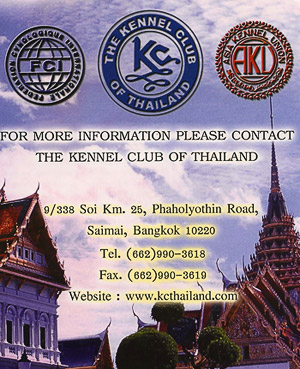
FCI-Standard N° 338 / 25. 02. 2004 / GB
THAI RIDGEBACK DOG
ORIGIN: Thailand.
UTILIZATION: Hunting and companion dog.
DATE OF PUBLICATION OF THE ORIGINAL VALID STANDARD: 26.05.2003.
FCI'S CLASSIFICATION: Group 5 Spitz and primitive types.
Section 7. Primitive Type-Hunting Dogs.
Without working trial.
BRIEF HISTORICAL SUMMARY: The Thai Ridgeback Dog is an old breed which can be seen in the archeological documents in Thailand which were written about 360 years ago. It was used mainly for hunting in the eastern part of Thailand. People also used it to escort their carts and as a watch dog. The reason why it has kept its own original type for so many years is due to poor transportation systems in the eastern part of Thailand; it had fewer chances to crossbreed with other breeds.
GENERAL APPEARANCE: Medium-sized dog with short hair forming a ridge along the back. The body is slightly longer than its height at withers. Muscles are well developed, and its anatomical structure is suitable for activities.
IMPORTANT PROPORTIONS:
Length of body: Height at the withers = 11: 1O
Depth of chest: Height at the withers = 1: 2
BEHAVIOUR / TEMPERAMENT: Tough and active with excellent jumping ability. A loyal family dog.
HEAD
CRANIAL REGION:
Skull: The skull is flat between the ears but slightly rounded when seen from the side.
Forehead: Wrinkles when the dog is attentive.
Stop: Clearly defined, but moderate.
FACIAL REGION:
Nose: Black. In blue dogs, the nose is bluish.
Nasal bridge: Straight and long.
Muzzle: Wedge-shaped, slightly shorter than skull.
Lips: Tight with good pigmentation.
Mouth: Black marking on the tongue is preferable.
Jaws: Upper and lower jaws are strong.
Teeth: White and strong with scissors bite.
Eyes: Medium size and almond shaped. The eye colour is dark brown. In blues, amber-coloured eyes are permitted.
Ears: Set on sides of the skull. Medium sized, triangular, inclining forward and firmly pricked. Not cropped.
NECK : Medium length, strong, muscular, slightly arched and holding head high.
BODY
Back: Strong and level.
Loin: Strong and broad.
Croup: Moderately sloping.
Chest: Deep enough to reach the elbows. The ribs are well sprung, but not barrel-shaped.
Lower line: The belly is well tucked up.
TAIL:Thick at base with gradual tapering toward the tip. The tip can reach hock joints. Carried vertically and slightly curved.
LIMBS
FOREQUARTERS:
Shoulder: Well laid back.
Forearm: Straight.
Pastern: Straight when seen from the front and very slightly sloping when seen from the side.
Feet : Oval
Nails : Black but can be lighter depending on coat colour.
HINDQUARTERS:
Thighs: Well developed with well bent stifles.
Hocks: Strong and well let down.
Rear Pastern: Straight and parallel when seen from the rear.
Feet : Oval
GAIT : Reachy stride with no pitching nor rolling of the body. Parallel tracking at normal speed. When viewed from the front, the forelegs move up and down in straight lines so that the shoulder, elbow and pastern joints are approximately in line with each other. When viewed from the rear, the stifle and hip joints are approximately in line. Movement in a straight line forward without throwing the feet in or out; thus enabling the stride to be long and drive powerful. The overall appearance of the moving dog is one of smooth flowing and well balanced rhythm.
SKIN: Soft, fine and tight. Throat: no dewlap.
COAT
Hair: Short and smooth. The ridge on the top region is formed by the hair growing in the opposite direction to the rest of the coat. It should be clearly defined from other parts of the back. There are various shapes and lengths of ridge, but must be symmetrical on either side of the backbone and within the width of the back. Crowns or whirls at the head of the ridge are acceptable.
Colour: Solid colour: red, black, blue and very light fawn (isabella). Black mask is preferable in reds.
SIZE: Ideal height at the withers:
Dogs 22-24 inches (56-61 cm)
Bitches 20-22 inches (51-56 cm).
There is a tolerance of plus or minus one inch (2.5 cm).
FAULTS: Any departure from the foregoing points should be considered a fault and the seriousness with which the fault should be regarded should be in exact proportion to its degree and its effect upon the health and welfare of the dog.
- Any bite other than scissors bite.
- Unbalanced ridge.
ELIMINATING FAULTS:
- Aggressive or overly shy.
- Dogs without ridge
- Long hair.
Any dog clearly showing physical or behavioural abnormalities shall be disqualified.
N.B.: Male animals should have two apparently normal testicles fully descended into the scrotum.


http://www.tv5.co.th/newss/tv5tv.php?transid=77170
Thai Ridgeback dog on television.
Ridge
collection
Some names of ridge forms are my idea. Olga Pevunova
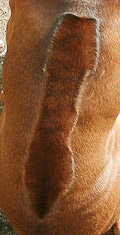 Tie |
 Rocket |
 Rocket |
 Lizzard |
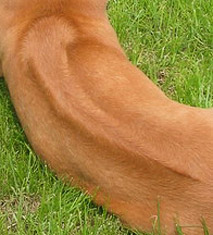 Arrow |
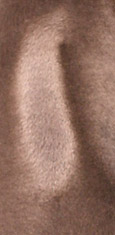 Pin |
 ridge of Nuh |
 ridge of Paitoon NEO |
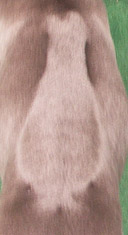 |
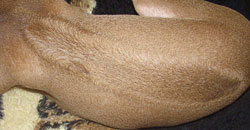
ridge of Manaw - classic bowling ridge
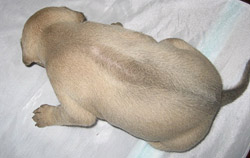
isabella puppy
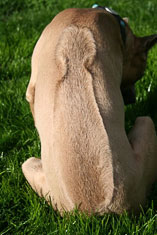
Bell Apple SIBUA |
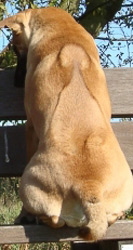 Kito |
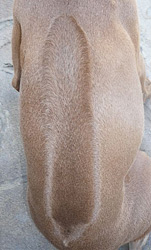 |
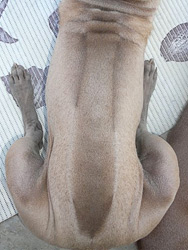 |
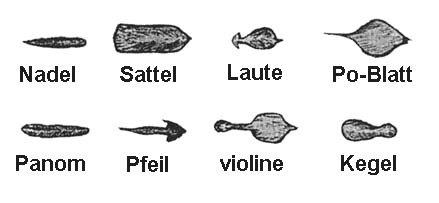
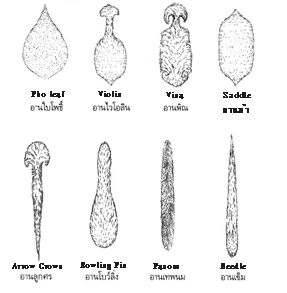
Color collection
Black
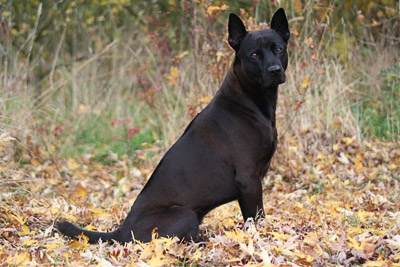
Taja's father Filou
Manaw, owner Elena and Andrey Formanchuk, Simferopol, Ukraine
Color genetics
Manaw , Isabella
Owner: Elena & Andrey Formanchuk
Breeder: Mr. ATHIP TRONGTANACHAOENKU
| PETCH NGAM SAKSIAM KENNEL fawn |
TH.CH.TOP blue |
blue |
| blue | ||
| NONG NUCH OF SAKSIMKUL blue |
blue | |
| blue | ||
| BANSPRITHAIS’ BUA fawn |
NUENG blue |
blue |
| black | ||
| TUL OF BANGKHEN blue |
blue | |
| red |
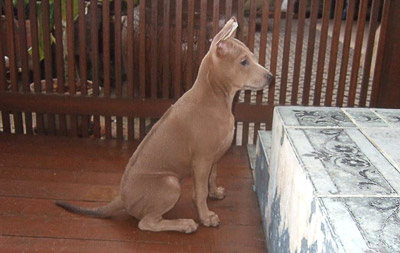

Another isabella dog lives in Germany
in Lappe family with Taja's brother Caju - see.
Our relatives.
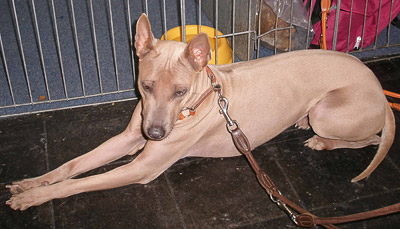
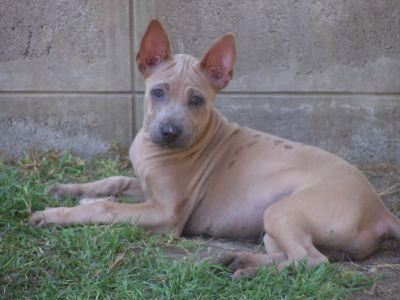
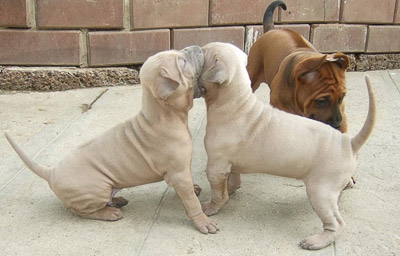
Isabella and red
Photo taken from Ridgeback forum (See Links)
2012
A while ago we were approached by Brazilian Dogmagazin with a request to answer a few questions regarding our beloved breed. Down below you can find our answers.
Thai Ridgeback Dog is a little bit more popular in Russia (approximately - about 120 registrations in 2011) than in other countries. The questions are
1) In our opinion, what are the qualities of the Thai Ridgeback Dog that draw the attention of the Russian people? And why this breed is so rare worldwide and not recognized by The Kennel Club, The Canadian Kennel Club and the American Kennel Club?
Russia is a vast country with a very rich cynological history and a high demand among its different peoples for dogs as assistants (shepherds, guards, in the police and army) and companions.
The long isolation from other counties during the socialist period and the opening of the borders in the 90-ies resulted in a splash of interest in the population in earlier unknown breeds. A taste for exotics developed… And the Thai Ridgeback is an extraordinary breed! Just show me any other breed with such patterns on the back (only the rhodesian ridgeback has the ridge, but only of one type, whereas the Thai Ridgeback has 8 and with variations!) In this county people have emerged with a great interest in this exotic breed and they have been doing a lot to popularize it through cynological magazines, Websites and exhibitions.
2) So why does this breed remain rare?
Because Thailand opened up for Europe (tourism) only in the late 70-ies of the 20th century. And for Russia it was 20 years later. The Europeans discovered the Thai Ridgeback, got interested in the breed, began to buy it and evoked cynological (and commercial) interest in the Thailanders. Any breed is part of the culture and history of a nation. If a nation values its culture and history then sooner or later it will want to develop cynology as part of its culture. For breeding cynology it is important that there are wealthy and high-cultured people who have means to keep up breeding and advertising of the breed. Such people emerged in Thailand not overnight (the breed is many ages old, but Thailand used to live a rather isolated life, besides the living standards were quite low and the attitude toward dogs was pure exploitative). At the moment FCI acknowledges about 450 breeds. Therefore it takes a lot of advertising and promotion to get a new breed acknowledged. The acknowledgment procedure is rather complicated (you have to present a certain number of females and a few non-kindred lines, etc.), yet in the EEC countries volunteers take a remarkable effort to support breeding of unrecognized yet prospective breeds. These unrecognized breeds participate in exhibitions without getting international titles. The first standard of the Thai Ridgeback was established in 1997, in 2004 it was amended. 30 years of breeding is a very short period. Long recognized breeds count a few ages of PROFESSIONAL breeding, i.e. targeted breeding (like borzoi, greyhound, terriers and some others).
Like all the aboriginal (primitive) breeds the Thai Ridgeback has some qualities not everybody may like – aboriginal dogs sometimes show instincts characteristic of animals living a half wild life: for ages they lived close to people buy not in their homes. They fed themselves. These dogs have explicit self-preservation instinct regarded in certain cases as fearfulness. In the domestication of dogs their natural self-preservation instinct through targeted selection was deliberately weakened. The dog was supposed to sacrifice its life and health for the property and cattle of the man or offer it for the benefit of the man’s passion. Primitive dogs are distrustful of strangers and unfamiliar phenomena. Not all are ready to cooperate with humans. Some use their teeth to communicate. That’s why one of the main tasks of breeders is targeted selection aimed at getting the right temper. Unfortunately in their home country due to the Thailanders’ preferences these dogs don’t live in close contact with humans in their homes as is the case in Europe and Russia, instead they are kept in open-air cages and yards. Also in Thailand they are considered as guarding dogs and, unlike in Europe, their aggressiveness is welcomed. Here we have a certain controversy because the standard does not define the Thai Ridgeback as a guarding breed. According to the standard the Thai Ridgeback is a companion and faithful family dog.
In Russia the Thai Ridgeback is valued for its original appearance, medium size, extraordinary cleanliness, no hair or saliva shedding (change of coat once a year during 3 weeks), low consumption of feed and yet its high assimilability, faithfulness and readiness to guard. Thai Ridgebacks, especially males, may be aggressive to other males and strangers, they have an explicit guarding instinct. Many Russians like that. In Russia people value strong dogs and don’t get frustrated over occasional bites; in Europe the bitten normally runs to the Police and demands a sleep-down.
Despite its medium size the Thai Ridgeback is very muscular and sporty. The stare of the Thai Ridgeback is intent and piercing, the well-developed body build and muscles (especially males’) call for respect. Actually its appearance scares off, which is appreciated in Russia with the country’s level of crime.
Even a woman will feel comfortable strolling late in the park if accompanied by a male Thai Ridgeback (bitches are smaller and look less menacing).
One of the good qualities of the Thai Ridgeback is its quietness – it barks only on discovering a stranger on its territory. No silly yapping at the door over every sneeze of the neighbor.
A great advantage of these dogs is their natural laziness. Young dogs are active, grown-ups will be content with a couple of 30-minutes walks per day (the best would be 2 hours or more per day, of course). Adult dogs don’t require regular training as the working breeds do. They like home coziness, warmth, the owner’s sofa or, if lucky, one of their own. Nevertheless they are playful and will joyfully accompany the owner on his or her bicycle ride. In Europe there are enthusiasts that do agility with their Thai Ridgebacks. I know one dog that has qualified a “rescue dog”. Most of our breeders and owners of Thai Ridgebacks have different jobs and are very busy people or your mothers that love to spend their family weekends out of town or at dog shows.
3) Nowadays, what are the current functions of the Thai Ridgeback Dog in Russia and in the world ?
The use of the Thai Ridgeback for hunting is of no interest for the Russians, as there is a sufficient number of trained hunting dogs. Besides a baiting dog (hound) (and the Thai Ridgeback used to be a baiting dog – it catches the bird with teeth) would cause a lot of trouble to its owner both in town and in the country side, trying to chase birds in parks or hunting for smaller pets, for example. Therefore we are hard at killing the hunting instincts in the Thai Ridgeback. By its nature the Thai Ridgeback is inclined to go far in his search which only means problems in town. Should it catch a squirrel in the park and you are guaranteed a big headache with the park visitors that may bring you to the Police on charges of animal abuse. Besides the short hair of the Thai Ridgeback will restrict its use as a hunting dog in our cold climate.
In Thailand the Thai Ridgeback is used on a large scale as a strict guarding dog (many guard jails and their owners’ property), for finding drugs and explosives at airports, i.e. the breed is regarded as a service breed. There are also cases of using it as a hound dog.
We in Russia consider the Thai Ridgeback as a companion dog – in compliance with the breed’s standard. So the mission of the Thai Ridgeback is to decorate and enrich the life of its owner, to entertain him and his family members, to satisfy their ethical and spiritual needs in communicating with the dog.
4) In Russia, about how many percent of the Thai Ridgeback Dog is kept living with access indoors ? And how many percent of the Thai Ridgeback Dog is kept living only outdoors ?
In our cold climate the Thai Ridgeback cannot live outdoors: in winter (november-march) the temperature sometimes falls to -30 degrees Centigrade, in April and September the average temperature is +10. Warm are only 4,5 months a year.
The Thai Ridgeback withstands heat well and dislikes cold and moisture. And it doesn’t swim in the river, even in heat, and wherever possible avoids puddles, which is good – stays cleaner.
Our dogs live with us in our home, hence our high requirements to their loyalty towards the family members. Their guarding qualities we are working down. In winter down to – 15° my dogs go without coats, in colder days we put warm jackets on them for longer walks.
5) In Russia and in the world, which is the most common (popular) and the most rare color ? And, In Russia and in the world, which is the most common (popular) ridge shape and the most rare one ?
In Europe the most popular color are blue and black, followed by red and isabel.
In Thailand the most popular are red dogs. Other colors are scarce and bred only for Europe.
In Russia there are lovers for all the colors, though initially blue prevailed as the rarest among dogs.
In the Thai Ridgeback breed the requirements to the form of the ridge are not as strict as with the Rhodesian Ridgeback.
Eight basic forms of the ridge are known: needle, arrow, panom, saddle, leaf, guitar, violin and skittle. In Europe and Russia the most common are arrow, skittle and needle. In the past 7,5 years I saw saddle and leaf only once. But this proportion may change. When selecting a dog the breeders first of all look at the general anatomy and character.
Typical of the breed diseases: from hereditary dermoid sinus.
Dogs of delute colors (blue and Isabel) are susceptible to allergies, dermatitis and immunodeficiency.
The maximum trd’s life span known to me: 14-15 years.
The character and training peculiarities: require persistent socialization.
By their character they resemble cats: independent, territory-minded, need motivation for training, stunningly smart, but sometimes slow in following orders, like comfort and demand respectful treating, love freedom, very hierarchy-minded, loyal only to the families they live in, very incredulous to strangers.
Other breeders also participated in the above questionnaire. On the basis of our answers the magazine has published an article (in Portuguese). A scan of this article is down below. We can only hope that our answers were translated correctly.



